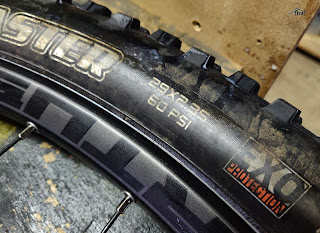I am a fan of tubeless tyres. Mainly, I like being able to ride without having to stop for punctures.
First job was to fit the tube tape to the rim. The tape supplied with the Hope wheel was a thin plastic which was fairly stiff. I found this a bit of an odd choice because it has to curve in both directions and this tape didn't want to do that.
I fitted it as best I could, working round the wheel to get as many of the bubbles out as possible. Mainly I made sure I had sealed round every spoke hole. I used a cloth to keep going round the rim and attempt to bend the tape to the shape of the rim.
The result was not as tidy as I was expecting to be able to achieve but eventually had to accept I wasn't going to get it any better.
I cut out the hole for the valve and tidied up the edges, as best I could.
I tried to get the tyre off the previous wheel without loosing too much Stan's Tire Sealant. The tyre was easy to get off with a couple of tyre levers. I lost about half of the tyre sealant, transferring the tyre to the new wheel. It made a mess on the workbench so I ended up putting a wadge of paper towel under the tyre to soak up what came out.
I had watched the Stan's video on how to fit tubeless tyres and was following their suggestions for the most part.
I got most of the tyre bead inside the wheel rim but before closing the last bit, I sloshed in a fair quantity of Stan's No Tire, Tire Sealant, to the bottom of the tube. I'd guess, over 100ml (about 4 oz).
I used two tyre levers to get the last bit of the tube lip inside the wheel rim. I lost a bit of sealant doing that but not too much. I rotated the wheel a couple of times to spread the sealant about.
From what I have read, getting the bead to seat is the bit that people have trouble with. I have a full size car air compressor, which makes that job fairly trivial.
I have modified an air blower, with a thin nozzle and a rubber grommet. I set the air compressor to near it's maximum 90 psi (6 bar).
I inflated the tyre without the valve core in, so that I could inflate it as quickly as possible. To my mind this helps to get the beads to seal on the edges of the rim, which helps to inflate the tyre.
I rapidly inflated the tyre to it's maximum 60 psi (4 bar) and checked round both sides to see if there was any sign of leaking. My own tip is to let the tyre deflate and see where the rim comes away from the bead and inflate the tyre again until I am sure the bead has seated. I pulled on the side walls at any point that did not look completely even.
I was pleased that my poor looking rim tape was sufficiently sealed to hold the air in.
As I had done this without a valve core, the tyre deflated when I released the air blower. As that was obviously going to happen, I made sure that the tyre was not pulled off the rim, by laying it horizontal.
I left it for a while, over pressure, at 3 bar (about 40 psi) to make sure the tyre was holding air and then once I'd finished fitting the brake disc and cassette, I dropped it down to about 2 bar (about 30 psi).
Once on the bike, the gear change had to be adjusted. The cassette probably sat no more than a millimetre different to the previous but that made it necessary to redo all the setup.
The following morning and the tyre is still fully inflated.
:-)
==















No comments :
Post a Comment